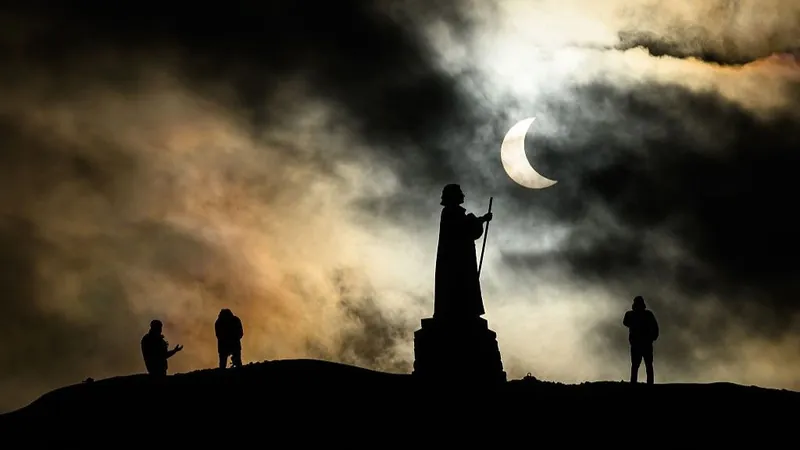
Spectacular Partial Solar Eclipse Captivates Skywatchers Worldwide (with Stunning Photos!)
2025-03-31
Author: Noah
Spectacular Partial Solar Eclipse Captivates Skywatchers Worldwide (with Stunning Photos!)
On March 29, a breathtaking partial solar eclipse dazzled observers around the globe, as the moon took a significant "bite" out of the sun. This celestial event presented skywatchers with remarkable sights, from crisp crescent-shaped suns to the rare phenomenon known as "devil's horns" — leaving many in awe, especially those fortunate enough to be in the ideal viewing locations.
The partial solar eclipse commenced at 4:50 a.m. EDT (0850 GMT), peaking at 6:47 a.m. EDT (1047 GMT), with the most stunning views reported from various parts of North America and Europe. Unlike a total solar eclipse, where the sun is completely obscured, the moon only partially covered the sun; thus, observers had to equip themselves with solar viewing glasses or filter their cameras, telescopes, and binoculars to safely enjoy the spectacle.
For many, including those residing in the U.K., this solar eclipse was a momentous occasion. Cloudy weather typically hampers celestial viewing in this region, but on this day, the skies cleared just in time for a front-row seat to the astonishing show. Armed with makeshift viewing tools like kitchen colanders along with specialized solar glasses and binoculars, enthusiasts in Nottingham, U.K., rejoiced.
Photographer Andy Moran captured a stunning image of the event from Nottingham, showcasing a visible sunspot as the moon edged across the sun. "After a disappointing lunar eclipse just weeks ago, the opportunity to witness and document this solar eclipse was thrilling," said Moran.
At the historic site of Stonehenge, the gods of weather were kind, allowing for breathtaking views of the eclipse above the ancient monument. Astrophotographer Josh Dury expressed his excitement in a video update, stating, "The skies cleared up just perfectly, making this one of the best spots in England for the event."
The partial solar eclipse also offered a captivating scene over the statue of Hans Egede in Nuuk, Greenland, where photographer Leon Neal captured a magnificent deep partial eclipse in action. Another stunning image from Nuuk showed a fine crescent of sunlight peeking through the dimming moon.
In France, despite battling through a shroud of clouds, the partial solar eclipse delivered an ethereal display, much to the delight of viewers. Observers gathered at the Keele Observatory in the U.K. to share their excitement, captured beautifully by photographer Nathan Stirk.
Liverpool's iconic Royal Liver Building became the backdrop for a striking image taken by Paul Ellis, showcasing the eclipse's shadow over its famous Liver Bird statue. Meanwhile, in northern Spain, residents used protective screens to watch the celestial wonder unfold from the hill overlooking Burgos' castle.
Looking ahead, if this thrilling eclipse has sparked your interest in more cosmic events, another partial solar eclipse is scheduled for September 21, 2025. However, this next spectacle will mostly be visible from remote regions of the Southern Hemisphere, so avid skywatchers may need to plan accordingly.
Feeling inspired by this celestial event? Dive deeper into your astronomical curiosity with our ultimate guide to observing the moon, perfect for planning your next adventure in skywatching, whether you wish to explore lunar seas, navigate mountainous terrains, or gaze at the countless craters that adorn our moon's surface. Don't miss out on the wonders of the night sky!









 Brasil (PT)
Brasil (PT)
 Canada (EN)
Canada (EN)
 Chile (ES)
Chile (ES)
 Česko (CS)
Česko (CS)
 대한민국 (KO)
대한민국 (KO)
 España (ES)
España (ES)
 France (FR)
France (FR)
 Hong Kong (EN)
Hong Kong (EN)
 Italia (IT)
Italia (IT)
 日本 (JA)
日本 (JA)
 Magyarország (HU)
Magyarország (HU)
 Norge (NO)
Norge (NO)
 Polska (PL)
Polska (PL)
 Schweiz (DE)
Schweiz (DE)
 Singapore (EN)
Singapore (EN)
 Sverige (SV)
Sverige (SV)
 Suomi (FI)
Suomi (FI)
 Türkiye (TR)
Türkiye (TR)
 الإمارات العربية المتحدة (AR)
الإمارات العربية المتحدة (AR)